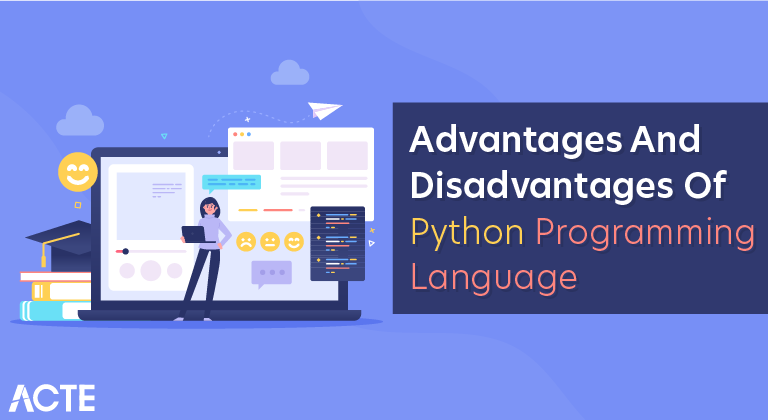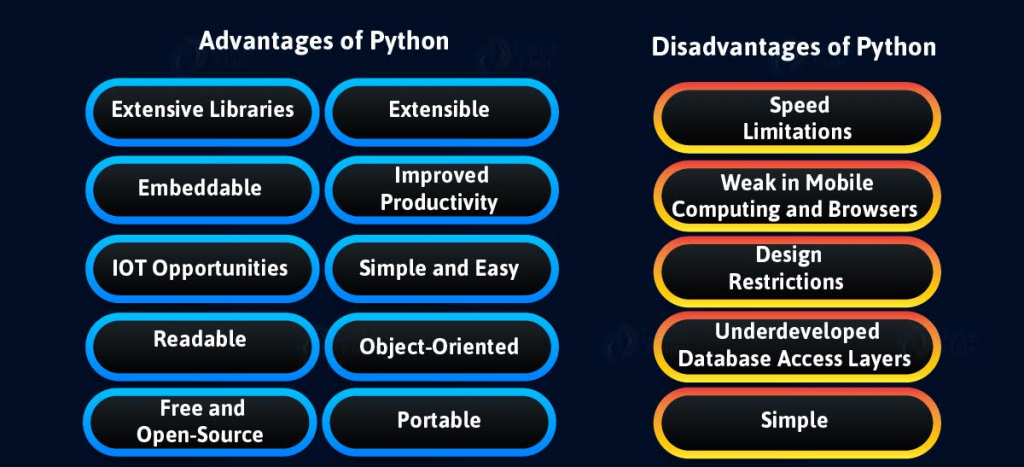
Must-Know Advantages & Disadvantages of Python & How to Master It
Last updated on 28th Jun 2020, Blog, General

- Let’s first discuss what advantages Python provides to its users. But before that, I hope you all are aware of what features Python provides to us.
- If not, first make yourself acquainted with the important features of Python. After that, it will be more easy for you to understand the advantages and disadvantages of Python.
- Compared to other programming languages Python is the most broadly applied by the developers lately. Within the next paragraphs, we will take a look at the advantages of Python programming language for developers in contrast with other languages.
- The main Python language advantages are that it is easy to read and easy to learn. It is easier to write a program in Python than in C or C++. With this language, you gain the possibility to think clearly while coding, which also makes the code easier to sustain.
- Which reduces the cost for maintenance of the program and seen as one of Python programming advantages.
- So, what are the advantages of Python that make this language special?
- The answer is that Python has some unique characteristics that are valuable for programmers because they make coding easier. Another advantage of Python programming is that no bug can originate a segmentation fault.
- An important advantage of Python language is that it has wide applicability, and is extensively used by scientists, engineers, and mathematicians.
- It is for this reason that Python is so useful for prototyping and all kinds of experiments. It is used in many groundbreaking fields. It is also used when producing animation for movies and in machine learning.
- The language includes a large library with memory management which is another one of the advantages of Python programming.
Advantages of Python
1. Extensive Libraries
- Python downloads with an extensive library and it contain code for various purposes like regular expressions, documentation-generation, unit-testing, web browsers, threading, databases, CGI, email, image manipulation, and more.
- So, we don’t have to write the complete code for that manually.
2. Extensible
- As we have seen earlier, Python can be extended to other languages.
- You can write some of your code in languages like C++ or C. This comes in handy, especially in projects.
3. Embeddable
- Complimentary to extensibility, Python is embeddable as well. You can put your Python code in your source code of a different language, like C++.
- This lets us add scripting capabilities to our code in the other language.
4. Improved Productivity
- The language’s simplicity and extensive libraries render programmers more productive than languages like Java and C++ do. Also, the fact that you need to write less and get more things done.
5. IOT Opportunities
- Since Python forms the basis of new platforms like Raspberry Pi, it finds the future bright for the Internet Of Things.
- This is a way to connect the language with the real world.
6. Simple and Easy
- When working with Java, you may have to create a class to print ‘Hello World’. But in Python, just a print statement will do. It is also quite easy to learn, understand, and code.
- This is why when people pick up Python, they have a hard time adjusting to other more verbose languages like Java.
7. Readable
- Because it is not such a verbose language, reading Python is much like reading English. This is the reason why it is so easy to learn, understand, and code.
- It also does not need curly braces to define blocks, and indentation is mandatory. This further aids the readability of the code.
8. Object-Oriented
- This language supports both the procedural and object-oriented programming paradigms.
- While functions help us with code reusability, classes and objects let us model the real world. A class allows the encapsulation of data and functions into one.
9. Free and Open-Source
- Like we said earlier, Python is freely available. But not only can you download Python for free, but you can also download its source code, make changes to it, and even distribute it.
- It downloads with an extensive collection of libraries to help you with your tasks.
10. Portable
- When you code your project in a language like C++, you may need to make some changes to it if you want to run it on another platform.
- But it isn’t the same with Python. Here, you need to code only once, and you can run it anywhere. This is called Write Once Run Anywhere (WORA). However, you need to be careful enough not to include any system-dependent features.
Disadvantages of Python
- As an interpreted language, Python has a slow speed of execution. It is slower than C and C++ because it works with an interpreter, not the compiler.
- The language is seen as less suitable for mobile development and game development. It is often used on desktop and server, but there are only several mobile applications that were developed with Python. Another disadvantage Python has is the runtime error.
- The language has a lot of design limits and needs more testing time. The programmer has the possibility to see bugs only during run time.
- Python has high memory consumption and is not used in web browsers because it is not secure. Language flexibility is considered among both advantages and disadvantages of Python.
- Developers like Python for its simplicity in learning and coding, so much that it might be difficult for some of them to learn and use other languages.
- In spite of all the disadvantages of Python programming language, it has a lot more pros than cons.

- So far, we’ve seen why Python is a great choice for your project. But if you choose it, you should be aware of its consequences as well. Let’s now see the downsides of choosing Python over another language.
1. Speed Limitations
- We have seen that Python code is executed line by line. But since Python is interpreted, it often results in slow execution. This, however, isn’t a problem unless speed is a focal point for the project.
- In other words, unless high speed is a requirement, the benefits offered by Python are enough to distract us from its speed limitations.
2. Weak in Mobile Computing and Browsers
- While it serves as an excellent server-side language, Python is much rarely seen on the client-side.
- Besides that, it is rarely ever used to implement smartphone-based applications. One such application is called Carbonnelle.
3. Design Restrictions
- As you know, Python is dynamically-typed. This means that you don’t need to declare the type of variable while writing the code. It uses duck-typing.
- But wait, what’s that? Well, it just means that if it looks like a duck, it must be a duck. While this is easy on the programmers during coding, it can raise run-time errors.
4. Underdeveloped Database Access Layers
- Compared to more widely used technologies like JDBC (Java DataBase Connectivity) and ODBC (Open DataBase Connectivity), Python’s database access layers are a bit underdeveloped.
- Consequently, it is less often applied in huge enterprises.
5. Simple
- No, we’re not kidding. Python’s simplicity can indeed be a problem. Take my example. I don’t do Java, I’m more of a Python person.
- To me, its syntax is so simple that the verbosity of Java code seems unnecessary.
Benefits of Python
- The Python language has diversified application in the software development companies such as in gaming, web frameworks and applications, language development, prototyping, graphic design applications, etc. This provides the language a higher plethora over other programming languages used in the industry. Some of its advantages are-
- Extensive Support Libraries
- It provides large standard libraries that include the areas like string operations, Internet, web service tools, operating system interfaces and protocols. Most of the highly used programming tasks are already scripted into it that limits the length of the codes to be written in Python.
- Integration Feature
- Python integrates the Enterprise Application Integration that makes it easy to develop Web services by invoking COM or COBRA components.
- It has powerful control capabilities as it calls directly through C, C++ or Java via Jython. Python also processes XML and other markup languages as it can run on all modern operating systems through same byte code.
- Improved Programmer’s Productivity
- The language has extensive support libraries and clean object-oriented designs that increase two to ten fold of programmer’s productivity while using the languages like Java, VB, Perl, C, C++ and C#.
- Productivity
- With its strong process integration features, unit testing framework and enhanced control capabilities contribute towards the increased speed for most applications and productivity of applications. It is a great option for building scalable multi-protocol network applications.
Limitations of Python
Python has varied advantageous features, and programmers prefer this language to other programming languages because it is easy to learn and code too. However, this language has still not made its place in some computing arenas that includes Enterprise Development Shops. Therefore, this language may not solve some of the enterprise solutions, and limitations include-
Difficulty in Using Other Languages
- The Python lovers become so accustomed to its features and its extensive libraries, so they face problem in learning or working on other programming languages. Python experts may see the declaring of cast “values” or variable “types”, syntactic requirements of adding curly braces or semi colons as an onerous task.
Weak in Mobile Computing
- Python has made its presence on many desktop and server platforms, but it is seen as a weak language for mobile computing. This is the reason very few mobile applications are built in it like Carbonnelle.
Gets Slow in Speed
- Python executes with the help of an interpreter instead of the compiler, which causes it to slow down because compilation and execution help it to work normally. On the other hand, it can be seen that it is fast for many web applications too.
Run-time Errors
- The Python language is dynamically typed so it has many design restrictions that are reported by some Python developers. It is even seen that it requires more testing time, and the errors show up when the applications are finally run.
Underdeveloped Database Access Layers
- As compared to the popular technologies like JDBC and ODBC, the Python’s database access layer is found to be bit underdeveloped and primitive. However, it cannot be applied in the enterprises that need smooth interaction of complex legacy data.

